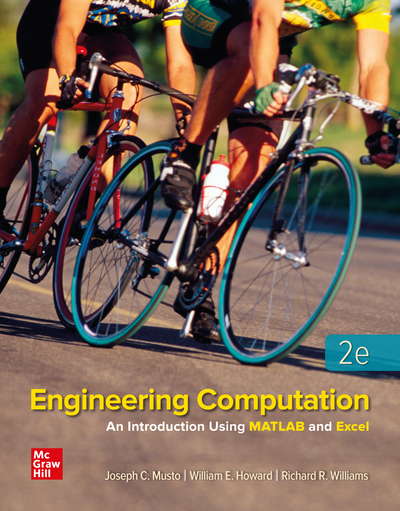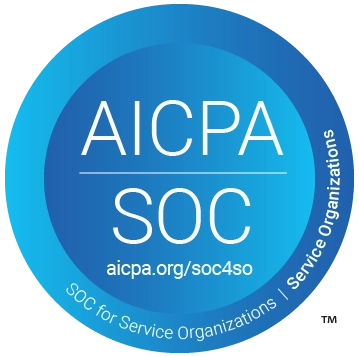Log In to My PreK-12 Platform


Engineering Computation: An Introduction Using MATLAB and Excel
Format Options:
-
Lowest Price!
eBook from $59.00 -
Print from $70.00 -
Connect from $118.96
McGraw Hill eBook
Textbook Rental (150 Days Access)
- Rent for a fraction of the printed textbook price
- Complete text bound in hardcover or softcover
Loose-Leaf Purchase
Unbound loose-leaf version of full text
Shipping Options
- Standard
- Next-day air
- 2nd-day air
Orders within the United States are shipped via FedEx or UPS Ground. For shipments to locations outside of the U.S., only standard shipping is available. All shipping options assume the product is available and that processing an order takes 24 to 48 hours prior to shipping.
Note: Connect can only be used if assigned by your instructor.
Connect (180 Days Access)
- Digital access to a comprehensive online learning platform
- Includes homework, study tools, eBook, and adaptive assignments
- Download the free ReadAnywhere app to access the eBook offline
* The estimated amount of time this product will be on the market is based on a number of factors, including faculty input to instructional design and the prior revision cycle and updates to academic research-which typically results in a revision cycle ranging from every two to four years for this product. Pricing subject to change at any time.
Instructor Information
Quick Actions (Only for Validated Instructor Accounts):
This text provides a detailed introduction to the computational techniques, numerical methods, and computational tools used by engineering students. It is aimed at first or second year students, and is intended to provide the theoretical and computational foundation required for advanced study in engineering. The text provides a foundation in computational theory, and an overview of thenumerical methods used by engineering students and practicing engineers. The text focuses on implementation of these computational techniques using two widely-used software packages: MATLAB, which provides a structured programming environment, and Excel, which is a ubiquitous spreadsheet application. Throughout the text, these two softwares are used to demonstrate the computational techniques developed in the text, and their advantages and limitations are described.
PART 1
Chapter 1: Computing Tools
Chapter 2: Excel Fundamentals
Chapter 3: MATLAB Fundamentals
Chapter 4: MATLAB Programming
Chapter 5: Plotting Data
PART 2
Chapter 6: Finding the Roots of Equations
Chapter 7: Matrix Mathematics
Chapter 8: Solving Simultaneous Equations
Chapter 9: Numerical Integration
Chapter 10: Optimization
Main Features
- LMS Integration
- Print/Loose-Leaf Book Add-On Availability
- Presentation Slides & Instructor Resources
- Question & Test Banks
- Adaptive Assignments
- Student Progress Reporting & Analytics
- Essay Prompts
- Polling
- Prebuilt Courses
- Interactive Exercises
- eBook Access (ReadAnywhere App)
- Remote Proctoring (Proctorio)
- Subject-Specific Tools
About the Author
Joseph Musto
Joseph Musto holds a B.S. from Clarkson University, and an M.Eng. and Ph.D. from Rensselaer Polytechnic Institute, all in mechanical engineering. Before beginning his academic career, Dr. Musto worked in industry in held industrial positions with Brady Corporation (Milwaukee, WI) and Eastman Kodak Company (Rochester, NY). He is a registered professional engineer in the state of Wisconsin. He has been using and teaching solid modeling using SOLIDWORKS since 1998.
William Howard
William "Ed" Howard holds a B.S. in civil engineering and an M.S. in engineering mechanics from Virginia Tech, and a Ph.D. in mechanical engineering from Marquette University. He is an associate professor in the East Carolina University Department of Engineering, where he teaches solid modeling, engineering computations, solid mechanics, and composite materials. Before beginning his academic career, Dr. Howard worked in industry for 14 years in design, analysis, and project engineering at Thiokol Corporation (Brigham City, UT), Spaulding Composites Company (Smyrna, TN), and Sta-Rite Industries (Delavan, WI). He is a registered professional engineer in the state of Wisconsin.
Richard Williams
Accessibility
Creating accessible products is a priority for McGraw Hill. We make accessibility and adhering to WCAG AA guidelines a part of our day-to-day development efforts and product roadmaps.
For more information, visit our accessibility page, or contact us at accessibility@mheducation.com
Affordability
Reduce course material costs for your students while still providing full access to everything they need to be successful. It isn't too good to be true - it's Inclusive Access.
Need support? We're here to help - Get real-world support and resources every step of the way.

